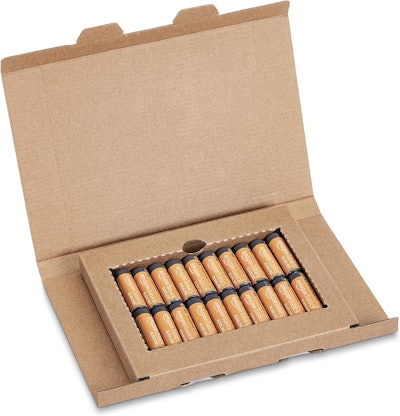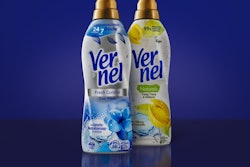
Material elimination through better packaging design is a solid first step in any company’s journey toward packaging sustainability. That’s according to Matt Swenson, manager at Amazon Private Brand Packaging, who spoke today at Sustainable Packaging Coalition’s Impact. Packaging that doesn’t serve an essential function, or serves a function that’s a a positive in some respects, but net negative to the whole system, should be directly removed. Other brands similarly need to consider product redesign, technologies, or reformulation help to eliminate unnecessary packaging components.
Case in point: Swenson recently completed a project in liquid and viscous products with dispensing mechanisms like sprays and pumps. Generally, a retailer that sells this type of product through e-comm or D2C ought to be concerned about damages during transport, as they entail strongly negative consumer perception impacts even before returns and reverse logistics are considered. A brand like Amazon wants to make sure that its products—especially its own private brand products—are arriving in their intended state to consumers. But dispensing closures are far more likely to fail during shipment than less complicated closures. So Swenson and his team started imagining how to deliver nearly the same consumer experience in this product range, but with less chance of damage during shipping. “Where doesn’t the customer experience depend on the dispensing mechanism?” the team asked themselves.
A good example ended up being a sunburn relief aloe vera gel. The way the product is usually applied, a DSC cap closure wouldn’t move the needle much for many consumers. But some would still prefer to use the pump.
“We were able to take about half of our [aloe vera gel] selection, take them out of that highly susceptible packaging type, and move them into a more secure packaging type,” Swenson said. “This was a quick decision because it's a two-way door. If we decide that we want to walk back through it and the customer experience isn'e what we expected, or the damages don't resolve in the way that we thought they would, we can go back to our next production run bringing the pump back. But it did resolve the issue. We were still left with that half of a selection, so we so saw an opportunity for an experiment. We asked ourselves, ‘how can we disrupt the customer experience, ask them to take an action on our behalf, and give them a reward?' So we tested this hypothesis. If we're asking them for less than five seconds of their time, can we have them adopt our mission? Can we bring them in on this journey with us?’”
Both aloe vera gel lines—pump and DSC cap—were filled in the same bottle, a static variable. One had a pump on the side in the shipper, the other pump shipped on the bottle. The thought here was that consumers who were purchasing the gel the first time could jump right into, essentially, a starter kit. They just needed to unscrew the cap attach to the pump, and they'd have a bottle with a pump, adding only a few seconds. Amazon knows, a DSC cap, not the pump, is going to be the most secure way to deliver the product to the consumer without risking a leaker.
Then, there were also consumers who were interested in converting to a more sustainable option. That pump isn't finished working when the bottle is empty—it continues to function. Those consumers could potentially purchase another prefilled bottle with a DSC cap, apply the legacy pump over to the new bottle, and continue to use it.
“As of today, we've seen that each pump is being used about two and a half times. Hopefully that continues to accelerate over time,” Swenson found. “But we also have some interesting data that we weren't expecting. About 10% of our sales are now customers who were jumping directly into the refill bottle. It highlighted a different area that we could potentially look at for future launches. What is the true customer need? What are we solving for? And how are we making sure that when we bring products to market, we're giving our customers every opportunity to shop their preference?”
With such a broad portfolio of products among Amazon’s Private Brands, Swenson has to rely on data to guide him. He and his team look at it through a lens they call material intensity, which they calculate as grams of packaging delivered per cubic inch of product. That figures guides the team to look for higher intensities than what they’d expect for different product types.
Batteries constituted another product category scored unsettlingly high on the material intensity charts. This was surprising, as many of the battery options were certified SIOC (ships in own container), a program meant to optimize the system and minimize overpackaging. It consisted of robust packaging with the minimum 6- x 4-in spacing for which to affix a shipping label.
But over time, the SIOC format wasn't matching the customer journey. Consumers were purchasing batteries as part of larger orders, and these disparate items were being co-packed, along with the SIOC batteries, in larger cases at Amazon fulfillment centers.
“So we're able to take the immediate action of right-sizing the product to the package. We reduced our cube by about 33%, and we reduced our material utilization by 14%. But it really started with us asking that question, ‘what is this? What is the minimum level package for this product?’ And working backwards from manufacturing capabilities to customer expectations, then to requirements with a distribution network, it has us reimagining what this packaging needs to be, and then only implementing the materials that are going to be required to get it to the customer safely. It brings up new questions that we're trying to solve every day. But we're always going to rely on that data to guide us,” Swenson says.
For both of these material reduction projects, using Amazon’s own private brands had its pros and cons. Data about their own products is almost certainly easier to come by.
“But at the same time, you're further separated from the [co-]manufacturing environment. We are constantly working with our suppliers, trying to understand our products better, and make sure that they're guiding our actions. We find that they're the best stewards of the products. And the thing that we can do that advances change most rapidly is just be transparent about what our goals are, what our mission is, what targets we want to be heading toward; when allowing them to craft solutions that help us get there, with slight nudges here and there, to make sure that we're staying on an aligned path. But they’ve been incredible partners.” Compact by Design is part of the Climate Pledge Friendly family of certifications. Small packaging can get lost on a physical shelf. But on a virtual one, the certification rewards a brand for svelte packaging in consumers' eyes,.
Compact by Design is part of the Climate Pledge Friendly family of certifications. Small packaging can get lost on a physical shelf. But on a virtual one, the certification rewards a brand for svelte packaging in consumers' eyes,.
Virtual shelf inflates compact packs
Working with Amazon’s Climate Pledge Friendly program, Swenson also developed Amazon's first internal sustainability certification, Compact by Design, which celebrates products and packaging that achieve best-in-class efficiency. It's a group of sustainability-minded certifications that reward the products that carry them in consumers’ eyes. Compact by Design is the first internal certification that recognizes products that are delivered without additional air or water. It’s similar metric to the material intensity metric already mentioned. Certification logo
Certification logo
Brand owners selling through Amazon can look up Compact by Design, and it will walk them through a formula to arrive at the calculations on their products to see if they qualify or can get qualified.
“But if you are creating the most efficient package in your product category; if you're creating products that have less air or water than others in that space, then you can get that certification and be recognized by the customer,” Swenson said. “We've consistently heard that making a package and product smaller and more efficient gets them lost on the store shelf. This is our way to use the digital shelf to our advantage to draw attention to our customers who use more efficient products and ensure that they're getting the recognition.” PW



















